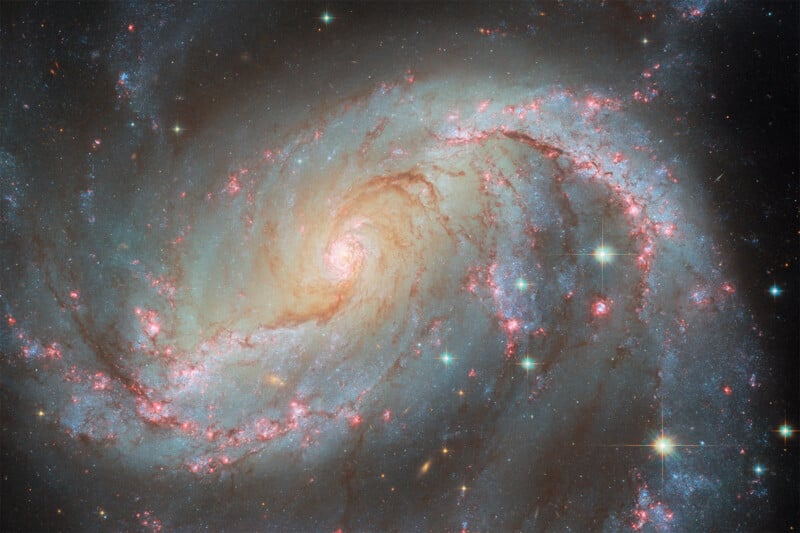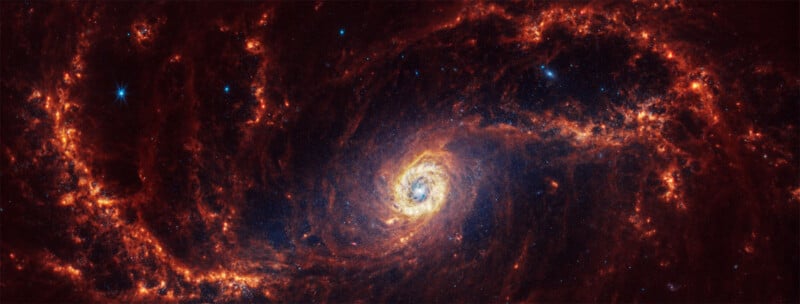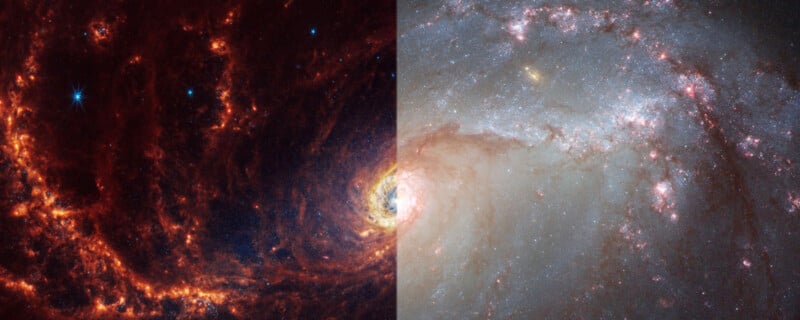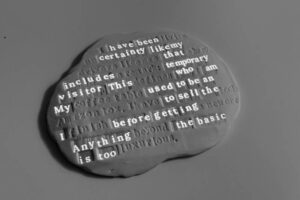 NGC 1672, as seen by the Hubble Space Telescope
NGC 1672, as seen by the Hubble Space TelescopeThe NASA/ESA Hubble Space Telescope continues to churn out fantastic space images. The latest captured by the 34-year-old telescope shows barred spiral galaxy NGC 1672 in all its luminous glory.
NGC 1672 is about 49 million light-years from Earth in the constellation Dorado. Like other spiral galaxies, NGC 1672 features large, distinct arms extending from its galactic core. In NGC 1672’s case, the two large arms shine due to hydrogen gas illuminated by radiation created by infant stars nestled in the interstellar gas and dust, shrouded from view.
These newly formed stars emit extremely powerful X-ray radiation, which has been previously observed by NASA’s Chandra Observatory. The new James Webb Space Telescope has also peered at NGC 1672 as part of its ongoing Physics at High Angular Resolution in Nearby Galaxies (PHANGS) program.
 NGC 1672 composite created using data from the Chandra X-ray observatory, Spitzer telescope, the Hubble Space Telescope, and the James Webb Space Telescope
NGC 1672 composite created using data from the Chandra X-ray observatory, Spitzer telescope, the Hubble Space Telescope, and the James Webb Space Telescope The James Webb Space Telescope’s view of NGC 1672, captured as part of the PHANGS collaboration
The James Webb Space Telescope’s view of NGC 1672, captured as part of the PHANGS collaborationNear NGC 1672’s center, Hubble spots the active galactic nucleus. “This X-ray powerhouse makes NGC 1672 a Seyfert galaxy,” NASA explains. “It forms as a result of heated matter swirling in the accretion disk around NGC 1672’s supermassive black hole.”
 ‘Hubble (right) and Webb (left) observations complement each other well, providing astronomers with a wide spectrum of light to study. Hubble’s observations showcase visible and ultraviolet light, while Webb’s combine near- and mid-infrared light. Dust absorbs ultraviolet and visible light, and then re-emits it in the infrared. In Hubble’s image, dark dust lanes are where starlight is absorbed. In Webb’s image, we see that dust glowing in infrared light,” NASA explains. In Hubble’s image, young stars appear blue and purple and fill the frame. In Webb’s images, newly-formed stars appear blue, but the orange stars are still forming and are cocooned in gas and dust.
‘Hubble (right) and Webb (left) observations complement each other well, providing astronomers with a wide spectrum of light to study. Hubble’s observations showcase visible and ultraviolet light, while Webb’s combine near- and mid-infrared light. Dust absorbs ultraviolet and visible light, and then re-emits it in the infrared. In Hubble’s image, dark dust lanes are where starlight is absorbed. In Webb’s image, we see that dust glowing in infrared light,” NASA explains. In Hubble’s image, young stars appear blue and purple and fill the frame. In Webb’s images, newly-formed stars appear blue, but the orange stars are still forming and are cocooned in gas and dust.This makes Hubble’s new image spectacular enough, but something else is happening in the image: a fleeting cosmic view of a supernova. Of the six images Hubble captured to create the final composite above, one included a supernova, SN 2017GAX. This was a Type I supernova “caused by the core-collapse and subsequent explosion of a giant star that went from invisible to a new light in the sky in just a matter of days.”
 The arrow is pointing at the supernova, SN 2017GAX, captured in one of Hubble’s six images used to create the final composite
The arrow is pointing at the supernova, SN 2017GAX, captured in one of Hubble’s six images used to create the final compositeThe supernova may appear small in the image above, but it is a massive deal to scientists. These transient events are challenging to spot and of significant interest to astronomers and physicists.
Image credits: Hubble images: ESA/Hubble & NASA, O. Fox, L. Jenkins, S. Van Dyk, A. Filippenko, J. Lee and the PHANGS-HST Team, D. de Martin (ESA/Hubble), M. Zamani (ESA/Hubble). | Webb image: NASA, ESA, CSA, STScI, Janice Lee (STScI), Thomas Williams (Oxford), and the PHANGS team. | Chandra image: X-ray: Chandra: NASA/CXC/SAO, XMM: ESA/XMM-Newton; IR: JWST: NASA/ESA/CSA/STScI, Spitzer: NASA/JPL/CalTech; Optical: Hubble: NASA/ESA/STScI, ESO; Image Processing: L. Frattare, J. Major, and K. Arcand.









 English (US) ·
English (US) ·